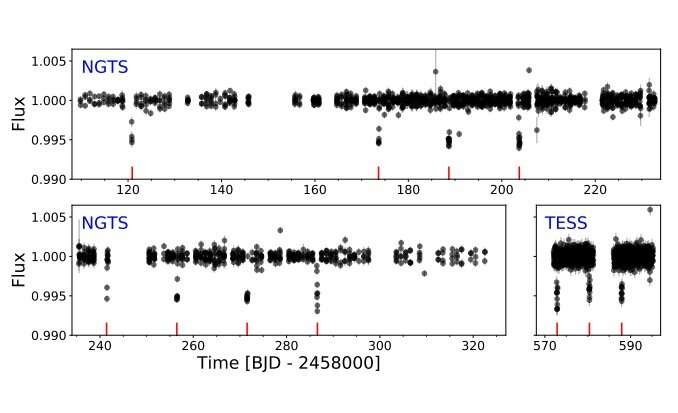
An international team of astronomers has discovered a new gas giant alien world as part of the Next Generation Transit Survey (NGTS). The newly found exoplanet, designated NGTS-12b, is about the size of Jupiter, but more than four times less massive than the solar system's biggest planet. The finding is reported in a paper published September 22 on arXiv.org.
NGTS is a wide-field photometric survey focused mainly on the search for Neptune-sized and smaller exoplanets transiting bright stars. The project uses an array of small, fully-robotic telescopes at the Paranal Observatory in Chile, operating at red-optical wavelengths. It uses the transit photometry method to find new exoworlds, which precisely measures the dimming of a star to detect the presence of a planet crossing in front of it.
Now, a group of astronomers led by Edward M. Bryant of the University of Warwick, U.K., reports the finding of another exoplanet from the NGTS survey. One of the NGTS telescopes observed NGTS-12—a star in the southern hemisphere estimated to be some 1,473 light years away. A transit signal was identified in the light curve of this star and follow-up spectroscopic observations confirmed its planetary nature.
"We report the discovery of the transiting exoplanet NGTS-12b by the Next Generation Transit Survey," the astronomers wrote in the paper.
The newly found alien world orbits its host every 7.53 days, which makes it the longest-period planet ever discovered by the main NGTS survey. The orbital period of NGTS-12b also turned out to be longer than the periods of 95 percent of other exoplanets detected by all ground-based transit surveys.
NGTS-12b has a radius of about 1.05 Jupiter radii and a mass of approximately 0.21 Jupiter masses, which allowed the astronomers to classify it as an inflated sub-Saturn-mass planet. The surface gravity and relatively low density of NGTS-12b suggest that it has an extended gaseous atmosphere.
The planet's host, NGTS-12, is about as massive as our sun and has a radius of approximately 1.59 solar radii. It has an effective temperature of around 5,690 K and metallicity at a level of -0.03. The age of the star is uncertain, but the authors of the paper assume that it is some 9.4 billion years old.
The astronomers noted that the derived parameters of NGTS-12b make it an interesting target for further spectroscopic studies focused mainly on the characterization of its atmosphere.
"We note that NGTS-12b has a reasonably high TSM [transmission spectroscopy metric], especially when compared to planets of similar and longer orbital periods. Therefore, NGTS-12b presents an opportunity to study the atmosphere of a planet on a longer period than the main population of currently known hot Jupiters," the researchers concluded.
Summing up the results, the scientists added that the detection of NGTS-12b shows that NGTS is able to find transiting planets that were not detectable to previous ground-based transit surveys.
Explore further
© 2020 Science X Network
Citation: New gas giant exoplanet discovered by NGTS survey (2020, September 30) retrieved 30 September 2020 from https://ift.tt/3l1eyNL
This document is subject to copyright. Apart from any fair dealing for the purpose of private study or research, no part may be reproduced without the written permission. The content is provided for information purposes only.
"gas" - Google News
September 30, 2020 at 08:00PM
https://ift.tt/3l1eyNL
New gas giant exoplanet discovered by NGTS survey - Phys.org
"gas" - Google News
https://ift.tt/2LxAFvS
https://ift.tt/3fcD5NP
Bagikan Berita Ini















0 Response to "New gas giant exoplanet discovered by NGTS survey - Phys.org"
Post a Comment